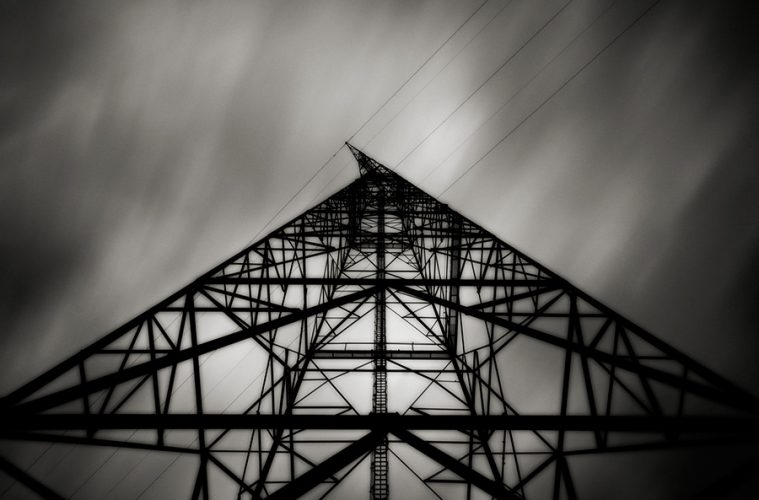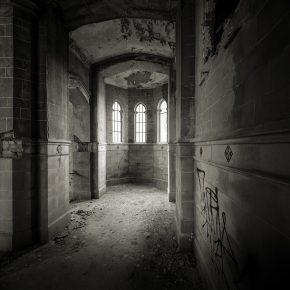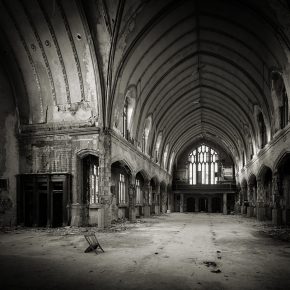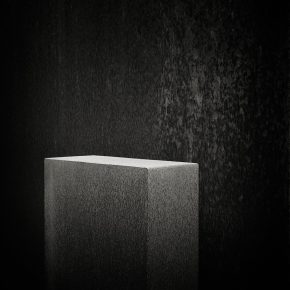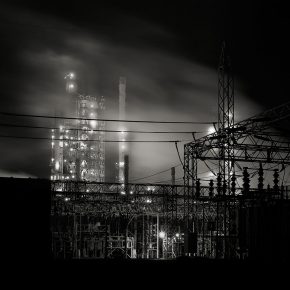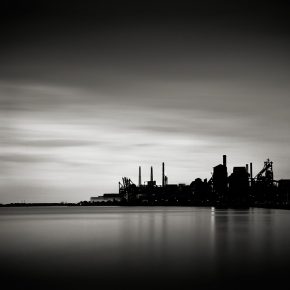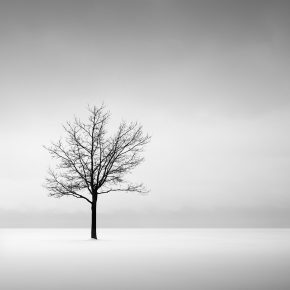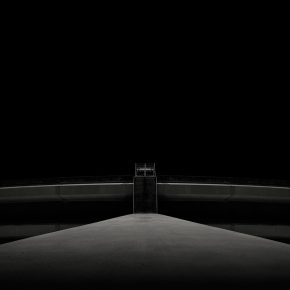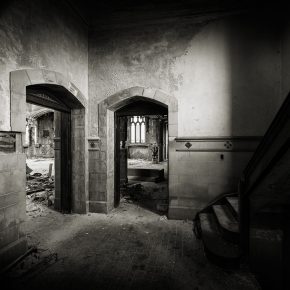Thinking back, I can’t quite remember when I discovered the photography of Jeff Gaydash – but my response was immediate.
An international award-winning fine art photographer, Gaydash creates striking black & white images of both natural and urban environments that for me do a fine and rare job in capturing singularity.
Aesthetically, his images are dark crystalline. They pull us deep into the unknown. But, they also convey a certain resiliency. There is hope in the abyss.
Having studied the masters of photography and the developing processes they used at Detroit’s College of Creative Studies (CCS), Gaydash came to admire “the aesthetic value of highly crafted photographic prints” and grew determined to master the art of B&W printmaking.
After years of experimentation, he discovered a system to convert a color inkjet printer into a grayscale specific device that used up to seven shades of ink. This development made it possible for the printmaker to create the extraordinary B&W images that have made Gaydash a world renown fine art photographer.
With recognition from several Fine Art Photography competitions including the PX3 Prix de la Photographie Paris, the International Fine Art, Grand Prix de la Découverte, and the International Photography Awards, it is a reminder that far too often we tend to overlook the brilliance that exists in our own backyards.
So, it is with great pleasure that I am able to share a series of questions that began a few years ago in a Ferndale bar. Jeff sat across a table from me quietly and confidently discussing his work. I knew then that I was sitting before a unique talent – one, while adept at conversation, preferred to communicate through his timeless imagery.
“The simplicity of a grayscale image gives the artist more room for artistic interpretation”
AB: Why don’t we begin with your love for black and white photography …
JG: Photography, by it’s nature, is very much a literal translation of the world we see around us, especially in comparison to other visually artistic mediums like drawing and painting.
For me, the simplicity of a grayscale image gives the artist more room for artistic interpretation than that of color photography. I became a student of photography in the pre-digital era. The first photographs I ever made were B&W prints in my high school darkroom, and I instantly fell in love with the process. From very early on I was drawn in by the unique aesthetic of well made B&W photographic prints and my passion for the craft became a never ending quest to create beautiful B&W images, an obsession that still continues after all these years.
AB: How do you determine what you are going to photograph? Can you take us through the process of location scouting and capturing the images?
JG: My approach varies, but generally speaking I research locations for a specific shot I’d like to make. For seascapes in particular I’ll use online satellite imagery to scan along coastlines looking for subjects. When something catches my eye I’ll search that particular location more in-depth to find photographs of that area to try and get a better idea of the surroundings. I’ll then assemble a few key locations within a specific area and base my travel agenda around my findings.
But the preliminary planning is just a starting point. Once out on a photo expedition, my mindset shifts gears and everything becomes a possible photographic opportunity. While driving to a location it’s not uncommon for me to suddenly slam on the brakes and pull a u-turn when I see something that interests me visually. Some of my best subjects were found this way. Great photographic opportunities are everywhere, you just have to be on the look out for them.
AB: I agree that opportunities are everywhere and yet you are able to pull details from a whole and still express a larger story, such as Solitude and Cube Squared. What is it about these objects and natural settings that grab your attention and what do you hope to express in the final images?
JG: It’s difficult for me to put into words and I find it best to let the images speak for themselves. Some general themes in my work are solitude, time (the passage of, lack thereof or of timelessness in general) and man vs. nature.
It’s taken me many years to cultivate an aesthetic, which I’ve developed mostly by following my own personal intuition. I tend to work subtractively, stripping a scene down to it’s most fundamental elements. Any hints of specific time and place are minimized as well. I value a strong sense of design and composition.
I’m interested in human achievement and our desire to try and control the world around us. Moreover, I’m in awe of the power of nature and it’s ability to continually reclaim itself. By juxtaposing man made objects with nature it becomes clear to me that nature will ultimately prevail over the efforts of man.
“I’m interested in human achievement and our desire to try and control the world around us”
AB: There are some extraordinary photographers that come to mind when I look at your images – Ansel Adams and Michael Kenna, for example – with whom you seem to share similar aesthetic: Whose work has moved you throughout your career?
Early 20th century British photographer Frederick Evans, known for his photographs of English and French cathedrals, was an early influence of mine. His beautiful platinum prints were a major source of inspiration for my senior thesis project at Detroit’s College for Creative Studies in the mid 1990’s, whereby I photographed churches and cathedrals of Detroit and made historic platinum prints from digitally created negatives. An ardent fan of the platinum printing process, Evans quit photography altogether when the price of platinum coated paper skyrocketed due to the onset of WWI.
Contemporary Japanese photographer Kenro Izu, known for his large format platinum prints of sacred places, has been a great influence on my landscape photography. One of his images in particular, taken on Easter Island of stone Moai statues juxtaposed against sweeping clouds and breaking ocean waves was a pivotal image in my move towards using long exposure techniques in my landscape work.
Both Evans and Izu’s exquisite platinum prints shaped my passion for high-end photographic printing, both the historic platinotype process as well as modern high-end digital inkjet printing of today.
AB: Speaking of printing processes how much of the final image is attributed to the artist, the photographic equipment, and the process of printing?
JG: Photography and imaging equipment are merely tools, but I believe that one’s artistic vision is of primary importance. High quality tools allow the artist to produce work at a higher level, but it’s also essential that one has the skills necessary to use the tools to their maximum potential. It all comes down to proper technique.
That being said, today’s most basic digital cameras (like the one in your smartphone) and image processing apps have made it incredibly easy for people with little to no photography experience to make really great photographs. This has made photography more accessible and raised the quality of photographs being made today by leaps and bounds.
AB: What are you feeling when you are making pictures in the field? Can you explain the reward of shooting pictures? And, is there a difference between the photographic process and working as a printer who is realising the final image?
JG: For me personally, making photographs is somewhat of a spiritual experience. I’m not referring to making casual photographs or snapshots, but rather when I go on a photographic outing and fully immerse myself in the process of making fine art images. I work very slowly and methodically. Perhaps this highly focused and deliberate process comes from my days of shooting with large format view cameras, which by their own nature demands a focused effort to make a single exposure.
Long exposure photography is particularly rewarding for me as the process is slowed down even further, often taking several minutes to make a single exposure. Like a view camera, most everything in camera is set manually including carefully composing the scene, metering, focusing and exposure. I become fully immersed in the image making process.
Landscape photography in particular is a collaboration with nature, you are working with changing light and weather. It requires a great deal of patience and I often find myself returning to a particular scene multiple times before I am able to capture the image set in my minds eye.
“Photography is more relevant now than it’s ever been”
An important concept here is one of “previsualization” which was coined by Ansel Adams. The idea is that one can see the final print in their head before the image has been captured. This takes years of practice and I believe cultivating this skill is one of the most important aspects of making great photographs. Adams broke down the photographic process into three parts; the camera (exposure), the negative and the print. Today’s digital process is much the same, in that there is the image capture, post-processing and (sometimes) the print. When I am in the field I am already visualizing in my head what I want the final printed image to look like. The capture, processing and printing are merely the three steps in the process of creating the image you visualized from the start.
AB: In the Age of Technology, there are more images out there on Instagram and other platforms, and the overall quality of photographs has improved, but at the same time it is often difficult to distinguish one photographer from the next. Any suggestions for amateur and aspiring professionals to develop methods for creating a fingerprint?
JG: I believe that aspiring photographers should start out by following their intuition and to not try to imitate what they have seen from other photographers. They should be open to all types of photography and not limited themselves to a certain style too early on. I think that’s a big mistake. An artist’s style may take many years to mature. Being fully aware and immersed in the process of making photographs is an important first step. Ask yourself “Why do I feel compelled to take this particular photograph? What am I trying to say?”
In regards to technology, this process is no different than it has been with traditional analog photography, the difference being that digital photography is much more forgiving and allows one to experiment more freely, with a greater amount of control.
Developing one’s inner creative vision is even more important in separating one from the masses of casual picture takers. Almost everyone is a photographer these days, having a camera phone at their disposal and instant access to various social media platforms such as Instagram give just about everyone a voice in the photographic realm. It’s really amazing to see the amount of great photographs being taken these days.
AB: What are your cameras and lenses of choice?
JG: In all honesty, digital camera’s have never really excited me all that much. While they are incredible tools with capabilities that continue to blow my mind, there is undoubtedly some magic that has been lost from the days of film photography. Always striving for the absolute highest image quality, I worked primarily with large and medium format film cameras; Deardorf, Sinar, Rolleiflex, Hasselblad, Zeiss and Rodenstock were all names that got my excited about making photographs.
Due to the small film size and lack of resolution, I never was much of a fan of 35mm format. I almost always used a tripod, and still do most of the time. Maybe the smaller form factor of todays DSLR’s and mirrorless cameras being so strikingly similar to the Nikon and Canon SLR’s of the past has something to do with my lack of enthusiasm for todays digital cameras.
I still shoot some film, primarily with a Cambo Super Wide 4X5, which has superior image quality. But we are all spoiled today with the incredible ease of a purely digital workflow. Digital technology has made being a photographer so much easier, making it harder to justify lugging around a large camera, not to mention the added time processing and scanning film.
AB: Finally, Jeff, I am curious to hear your thoughts on the importance of photography today – particularly in a video world. How do you see it remaining relevant?
JG: I think it’s more relevant now than it’s ever been. The sheer fact that there are so many amazing images shared online in such huge numbers attests to the fact of the relevance of photography today. I don’t see still photography as being in competition with video. They are both relevant and flourishing now more than ever.
Technological advancements have given the masses the opportunity to express themselves in both still and moving images, in ways we have never seen before. Social media has provided a global platform for sharing our creations to a virtually limitless audience.
It’s a great time to be a photographer!
AB: Jeff, I think you’re right …

